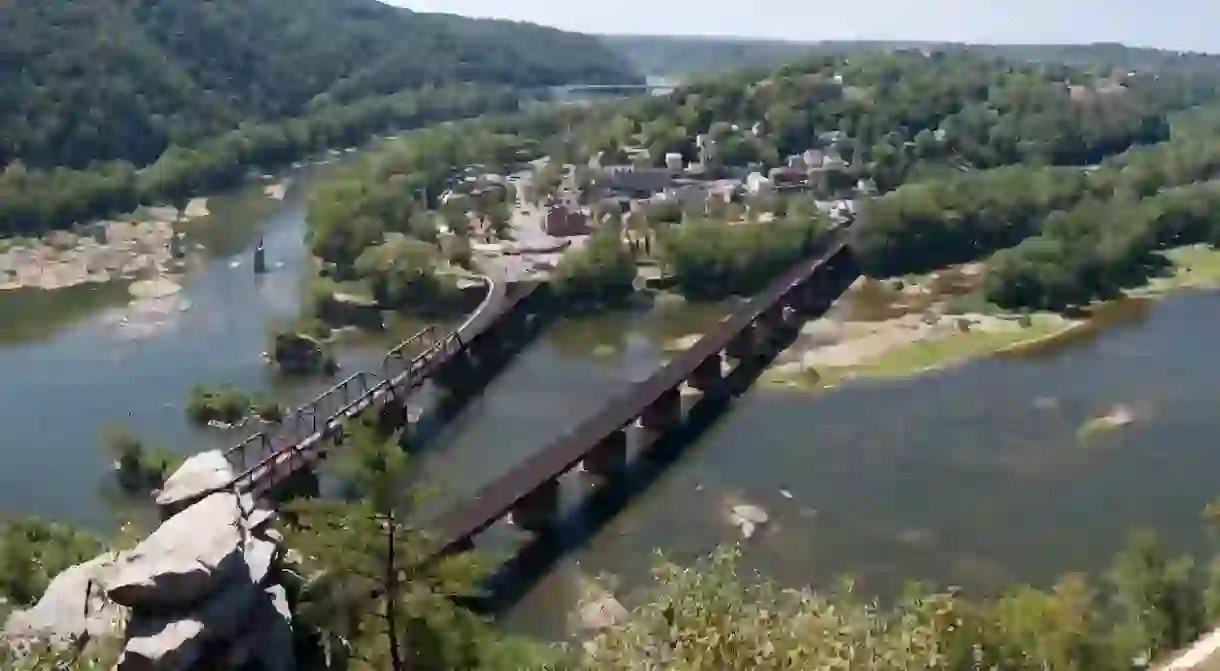10 Things You Didn’t Know About Harpers Ferry in West Virginia

Harpers Ferry, West Virginia, is known for the National Historical Park that documents the history of this small town in the state’s eastern panhandle, focusing mainly on the raid of abolitionist John Brown and the Civil War battle in town. And while those are vital parts of the town’s history, here are 10 facts you might not know that will give you a deeper and broader understanding of the area.
You can relive John Brown’s raid
In 1859, John Brown and a group of his followers attempted to raid a federal armory in Harpers Ferry to steal weapons and arm enslaved African Americans in the South, hoping for a revolt that would end slavery in the United States. While the Harpers Ferry National Historical Park interprets the physical spaces that were involved in John Brown’s raid, you can relive the experience in bloody detail at the John Brown Wax Museum. Life-size men of wax tell the story, from Brown’s planning to capture. Your best time to visit is during the summer when the museum is open daily.
W.E.B. Du Bois held his first U.S. meeting of the Niagara Movement in town
After meeting in Canada in 1905, Black activist and scholar W.E.B. Du Bois met with members of his Niagara Movement in Harpers Ferry in 1906. He chose the location not only because of the connection to John Brown but also because it was home to Storer College, a historically Black college and the only place where African Americans could attend college in the state at the time. Du Bois and the Niagara Movement were the beginning of the NAACP and the fight for equal rights for Black Americans.
The Appalachian Trail passes through the middle of town
The Appalachian Trail stretches along the Appalachian Mountains from Maine to Georgia and passes right through the center of Harpers Ferry. While not the exact midpoint of the trail, many who hike the whole trail at once (called thru-hikers) see the town as a psychological midpoint, and one that has lots of good places to rest and eat.

The town is named after Mr. Harper’s Ferry
A man named Peter Stephens first settled the town in 1732, which was then just thought of as the point where the Shenandoah and Potomac Rivers meet. In 1747, Robert Harper bought the rights to settle from Stephens and later established a ferry that crossed the Potomac River in 1761. By 1763, the Virginia General Assembly (West Virginia wasn’t a state yet) gave the town the name of “Shenandoah Falls at Mr. Harper’s Ferry,” which became Harpers Ferry.
The Shenandoah River flows north to meet the Potomac River
While the Potomac River flows south from Harpers Ferry to Washington, D.C. and empties into the Chesapeake Bay, the Shenandoah River flows north in Virginia through the Shenandoah Valley to Harpers Ferry. At “The Point,” the two rivers meet and flow southeast.

It had an early Confederate Monument controversy
In 1931, United Daughters of the Confederacy (UDC) and the Sons of Confederate Veterans (SCV) erected a monument in memory of a Black man who died during John Brown’s raid, which many people felt was making a false memory and martyr of the man. The statue moved in the 1970s. However, by 1995, people were demanding for it to be put back, and the National Park Service complied. Then, they faced further controversy for placing the statue in its original spot, and have been dealing with how to properly display and interpret the statue since.
Harpers Ferry is haunted
Ok, well, with all the death and destruction that Harpers Ferry has seen, you probably could have guessed that the town is haunted—if you believe in that sort of thing. The Historic Harpers Ferry Foundation and private companies are happy to take you on a spooky walk around town to learn where the ghosts are most active.

The population is less than 300 people
With such a large history and such a great wilderness getaway for residents of the D.C. metro area, it’s surprising that the population of Harpers Ferry is less than 300 people. More than half a million people visit just the National Historical Park each year, with more traveling to enjoy hiking, biking, and watersports nearby.
Thomas Jefferson loved Harpers Ferry
Harpers Ferry is a beautiful, quaint town, and we’re not the only ones who think so. In 1783, Thomas Jefferson was passing through the town and later wrote, “The passage of the Patowmac through the Blue Ridge is perhaps one of the most stupendous scenes in Nature.” Now, a rock with one of the most scenic views of the Potomac River bears his name.

You can bike from D.C. to Harpers Ferry
The Harpers Ferry National Historical Park butts right up against the Chesapeake & Ohio Canal National Historical Park. Built to haul goods up and down along the Potomac River, the hiking-biking trail now stretches from Georgetown in Washington, D.C. to Cumberland, Maryland. The path is great for a day ride while visiting Harpers Ferry, or ride all the way from D.C. for a multi-day adventure.













